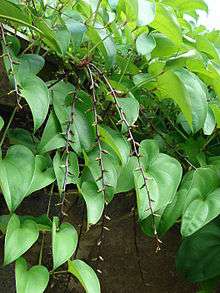Dioscorea alata
| Purple yam | |
|---|---|
 | |
| Purple yam at Maui, Hawaii | |
 | |
| Purple yam tuber | |
| Scientific classification | |
| Kingdom: | Plantae |
| Clade: | Angiosperms |
| Clade: | Monocots |
| Order: | Dioscoreales |
| Family: | Dioscoreaceae |
| Genus: | Dioscorea |
| Species: | D. alata |
| Binomial name | |
| Dioscorea alata L.[1] | |
| Synonyms[2] | |
|
List
| |
Dioscorea alata, known as purple yam or many other names, is a species of yam, a tuberous root vegetable. The tubers are usually vivid violet to bright lavender in colour, hence the common name, but they may sometimes be plain white. It is sometimes confused with taro and the Okinawa sweet potato (Ipomoea batatas cv. Ayamurasaki), although D. alata is also grown in Okinawa where it is known as beniimo (紅芋). With its origins in the Asian tropics, D. alata has been known to humans since ancient times.[3]
Common names
Because it has become naturalized throughout tropical South America, Africa, Australia, the southeastern U.S., D. alata has many different common names from these regions. In English alone, aside from purple yam, other common names include greater yam, Guyana arrowroot, ten-months yam, water yam, white yam, winged yam, or simply yam.[3] In other cultures and languages it is known variously as ratalu or violet yam in India, rasa valli kilangu (இராசவள்ளிக்கிழங்கு) in Tamil, dandila (දන්දිල) in Sinhala, thuppa genasu (ತುಪ್ಪ ಗೆಣಸು) in Kannada, thoona or soona kerungu (ತೂ/ಸೂಣ ಕೆರುಂಗು) in Tulu, kondfal (कोंदफळ) in Marathi, kachil (കാച്ചില്) in Malayalam, and khoai mỡ in Vietnam. For the Igbo people of southern Nigeria, it is called ji or ji abana; while for the Yoruba people of the southwestern Nigeria, it is called isu ewura.[4]
*qube / *ʔube can be reconstructed as the Proto-Malayo-Polynesian word for D. alata,[5] and words descended from it are found throughout the geographic range of this widespread language family, though in some daughter languages they are generalized or transferred to other root crops. Examples include Tagalog and Visayan ube or ubi, Malaysian and Indonesian ubi**, Malagasy ovy**, Fijian uvi, Tongan ʻufi, Samoan ufi**, as well as Māori and Hawaiian uhi. D. alata was one of the canoe plants that the Polynesians brought with them when they settled new islands.
** Not specific to D.alata
Uses
Culinary


Purple yam is used in a variety of desserts, as well as a flavor for ice cream, milk, Swiss rolls, tarts, cookies, cupcakes, cakes and other types of pastries. In the Philippines, it is known as ube and is often eaten boiled, baked, or as a sweetened pudding called ube halayá; the latter is a popular ingredient in the iced dessert called halo-halo. In Maharashtra, the stir-fried chips are eaten during religious fasting. Purple yam is an essential ingredient in Undhiyu.[6] Purple yam is a popular dessert in Jaffna, Sri Lanka. Ube has more recently appeared in American restaurants as well. It is being used to make truffles, leche, flan, donuts,[7] cupcakes, and other pastries.
D. alata is valued for the starch that can be processed from it.[3]
Medicinal
In folk medicine, D. alata has been used as a moderate laxative and vermifuge, and for fever, gonorrhea, leprosy, tumors, and inflamed hemorrhoids.[8] D. alata has relatively high levels of oxalates (486-781mg/100g dry matter).[9]
Other uses
The color of purple varieties is due to various anthocyanin pigments.[10] The pigments are water-soluble, and have been proposed as possible food coloring agents.[11]
D. alata is sometimes grown in gardens for its ornamental value.[3]
Weed problems
Dioscorea alata is native to Southeast Asia, as well as surrounding areas (Taiwan, Ryukyu Islands of Japan, Assam, lowland areas of Nepal, New Guinea, Christmas Island). It has escaped from its native growth area and into the wild in many other places, becoming naturalized in parts of southern and east-central China, Africa and Madagascar, the Western Hemisphere, and various islands in the Indian and Pacific oceans.[12] It persists in the wild in the United States in Louisiana, Georgia, Alabama, Florida, Puerto Rico, Haiti, and the U.S. Virgin Islands. It is considered an invasive species, at least in Florida.[13][14]
References
- ↑ Dioscorea alata was first described and published in Species Plantarum 2: 1033. 1753. "Name - Dioscorea alata L.". Tropicos. Saint Louis, Missouri: Missouri Botanical Garden. Retrieved May 26, 2011.
- ↑ "The Plant List: A Working List of All Plant Species".
- 1 2 3 4 GRIN (May 9, 2011). "Dioscorea alata information from NPGS/GRIN". Taxonomy for Plants. National Germplasm Resources Laboratory, Beltsville, Maryland: USDA, ARS, National Genetic Resources Program. Retrieved May 26, 2011.
- ↑ Samuel Oluwole Ogundele (2007). "Understanding aspects of Yoruba gastronomic culture". Indian Journal of Traditional Knowledge. 6: 50–56.
- ↑ Blust, Robert (2010). Trussel, Stephen, ed. "Austronesian Comparative Dictionary, web edition: *qubi yam: Dioscorea alata Linn.". http://www.trussel2.com/ACD. Retrieved 23 August 2013. External link in
|website=(help)[] - ↑ Degras, L. 1993. The Yam: A Tropical Root Crop. London, New York, and Wageningen
- ↑ "Donut Shop in Gurnee Cranks Out Unique Freshly Made Donuts". ABC7 Chicago. November 11, 2016.
- ↑ James A. Duke. "Dioscorea alata (DIOSCOREACEAE)". Dr. Duke's Phytochemical and Ethnobotanical Databases. Retrieved May 26, 2011.
- ↑ Wanasundera JP, Ravindran G (1994). "Nutritional assessment of yam (Dioscorea alata) tubers". Plant Foods Hum Nutr. 46 (1): 33–9. PMID 7971785.
- ↑ Moriya C, Hosoya T, Agawa S, Sugiyama Y, Kozone I, Shin-Ya K (2015). "New acylated anthocyanins from purple yam and their antioxidant activity.". Biosci Biotechnol Biochem. 79 (9): 1484–92. PMID 25848974. doi:10.1080/09168451.2015.1027652.
- ↑ Jinwei Li, Lianfu Zhang, and Yuanfa Liu (2013) "Optimization of Extraction of Natural Pigment from Purple Sweet Potato by Response Surface Methodology and Its Stability" Journal of Chemistry, volume 2013, article ID 590512, 5 pages doi:10.1155/2013/590512
- ↑
- Kew World Checklist of Selected Plant Families
- Flora of China, Vol. 24 Page 296, 参薯 shen shu, Dioscorea alata Linnaeus, Sp. Pl. 2: 1033. 1753.
- Smith, A.C. (1979). Flora Vitiensis Nova. A new flora for Fiji (Spermatophytes only) 1: 1-495. Pacific Tropical Botanical Garden, Lawai.
- Brunel, J.F., Hiepo, P. & Scholz, H. (eds.) (1984). Flore Analytique du Togo Phanérogames: 1-751. GTZ, Eschborn.
- Morat, P. & Veillon, J.-M. (1985). Contributions à la conaissance de la végétation et de la flore de Wallis et Futuna. Bulletin du Muséum National d'Histoire Naturelle. Section B, Adansonia 7: 259-329.
- Boudet, G., Lebrun, J.P. & Demange, R. (1986). Catalogue des plantes vasculaires du Mali: 1-465. Etudes d'Elevage et de Médecine Vétérinaire des Pays Tropicaux.
- George, A.S., Orchard, A.E. & Hewson, H.J. (eds.) (1993). Oceanic islands 2. Flora of Australia 50: 1-606. Australian Government Publishing Service, Canberra.
- Acevedo-Rodríguez, P. & Strong, M.T. (2005). Monocotyledons and Gymnosperms of Puerto Rico and the Virgin Islands. Contributions from the United States National Herbarium 52: 1-415.
- Tanaka, N., Koyama, T. & Murata, J. (2005). The flowering plants of Mt. Popa, central Myanmar - Results of Myanmar-Japanese joint expeditions, 2000-2004. Makinoa 5: 1-102.
- Akoègninou, A., van der Burg, W.J. & van der Maesen, L.J.G. (eds.) (2006). Flore Analytique du Bénin: 1-1034. Backhuys Publishers.
- Catarino, L., Sampaio Martins, E., Pinto-Basto, M.F. & Diniz, M.A. (2006). Plantas Vasculares e Briófitos da Guiné-Bissau: 1-298. Instituto de investigação científica tropical, Instituto Português de apoio ao desenvolvimento.
- National Parks Board Singapore (2006). Vascular Plant Life Checklist Pulau Ubin. www.nparks.gov.sg/nparks_cms/cms/cmsmgr/data/6/PlantChkList.xls.
- Sosef, M.S.M. & al. (2006). Check-list des plantes vasculaires du Gabon. Scripta Botanica Belgica 35: 1-438.
- Samanta, A.K. (2006). The genus Dioscorea L. in Darjeeling and Sikkim Himalayas - a census. Journal of Economic and Taxonomic Botany 30: 555-563.
- Pandey, R.P. & Dilwakar, P.G. (2008). An integrated check-list flora of Andaman and Nicobar islands, India. Journal of Economic and Taxonomic Botany 32: 403-500.
- Wilkin, P. & Thapyai, C. (2009). Flora of Thailand 10(1): 1-140. The Forest Herbarium, National Park, Wildlife and Plant Conservation Department, Bangkok.
- Demissew, S. & Nordal, I. (2010). Aloes and other Lilies of Ethiopia and Eritrea, ed, 2: 1-351. Shama Books, Addis Ababa, Ethiopia.
- ↑ "Profile for Dioscorea alata (water yam)". PLANTS Database. USDA, NRCS. Retrieved May 26, 2011.
- ↑ Biota of North America Program, 2013 county distribution map
External links
| Wikimedia Commons has media related to Dioscorea alata. |
| Wikispecies has information related to: Dioscorea alata |
- "Dioscorea alata". Integrated Taxonomic Information System. Retrieved 18 February 2006.
- Sri Lanka Rasa Valli Pudding
- Food Glossary, tarladalal.com
- Images from Forestry Images (webpages from the University of Georgia's Center for Invasive Species and Ecosystem Health)